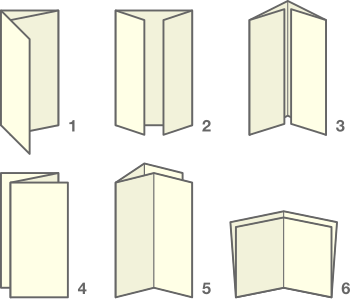Folding (paper technique)
In paper technology, folding is the creation of a sharp crease (fold line, fold break) on paper , cardboard or cardboard , which is produced with the help of a tool or a machine. If the crease is created without tools, it is called a fold .
In printing , bookbinding and cardboard production, a distinction is made between different techniques and forms of paper folding.
Tools
In the artisanal bookbindery, the so-called folder is used for folding , in industrial production with folding machines . There are two different methods for machine folding, pocket or buckled fold and knife fold.
Folding technology
preparation
The fold mark is set in preparation .
This may also include the grooving or creasing . In paper technology, grooving means the cutting out of a material chip in order to enable or simplify the folding or bending of the material; grooves mean the indentation of a break line.
Pocket fold
With pocket folds , the sheet runs into a pocket and is then folded by the back pressure ( upsetting , hence also upsetting fold ). The created sheet runs from the sheet infeed through the first two folding rollers and is then pushed against the pocket stop by these. As a result of this pushing, the sheet is compressed between the next pair of folding rollers until it grips it and executes the fold.
Pocket folding is a non-cycle-bound folding, which allows higher speeds than the knife fold. However, the fold breaks are less precise than with the knife fold.
Knife fold
To prepare an Schwertfalzes two folding rollers and a folding knife is required. The folding sheet is transported under the folding knife to a sheet stop and aligned. The folded sheet runs to the positioning mark, where a photocell signals the sword that the sheet has reached the stop. After triggering the sword movement, the sword strikes the sheet and presses it between the pair of folding rollers. The pair of rollers grips the sheet and breaks the fold, causing it to be folded in motion.
In contrast to pocket hemming, knife hemming is tied to a cycle, as the sword must move back to its starting position after each hinge. This means that less high speeds can be achieved than with pocket folding. However, the fold break is more accurate when folding with the sword.
Fold types
Parallel folds
In the simplest form, the parallel fold, all folds are parallel. The parallel folds include the letter fold, the gate fold, the Leporello fold and the parallel center fold. Parallel folds are often used in simple advertising materials.
Letter fold
The spiral fold is a form of parallel fold in which two or more equally wide parts of the folded sheet are folded around a sheet part without changing direction. The fact that the folds go in the same direction results in the eponymous winding. With two parallel folds, one folding sheet results in 3 sheets or 6 pages. One speaks here of a two-fold spiral fold. A three-fold letter fold results in 4 sheets or 8 pages and so on.
Gate fold (window fold)
The altar fold , more rarely also called window fold , owes its name to the similarity to three-part winged altars in churches. With this form of parallel fold, the outer parts of the folding sheet are folded inwards without overlapping. The altar fold has six sides, an additional break in the middle of the arch results in the eight-sided altar fold.
Leporello fold (zigzag fold)
The Leporello fold is a form of parallel fold, in which two or more parts of the folded sheet are folded in alternating directions. This results in a zigzag fold, which is why this shape is also called a zigzag fold. With two parallel folds, one folding sheet results in 3 sheets or 6 pages. One speaks here of a two-fold fan-fold fold. A three-part fanfold results in 4 sheets or 8 pages and so on.
Parallel center fold (V-fold)
The parallel center fold is a form of parallel fold in which a sheet is always folded in the middle in the same direction (V-fold). This can be done in landscape or portrait format. Two such folds result in 8 pages, this form is also known as a double parallel fold.
Swiss fold
The Swiss fold is a variant of the Leporello fold in which the first two folds do not change direction. When folded, the front and back cover the remaining zigzag-folded pages like a double-fold letter fold.
Cross fold
With cross fold , the sheet is folded several times at right angles . This process is used in the production of brochures, magazines and books for which the folding sheet is stapled and trimmed. The direction of the paper should run parallel to the last fold.
use
Printing and bookbinding
The pages of multi-sided sheets are arranged ( imposition ) in such a way that the product (brochure, work, etc.) has the correct page order after folding. In the case of works, the pages are usually provided with consecutive page numbers; in brochures these are often missing.
